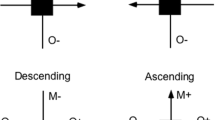Abstract
This study mathematically characterizes the results of DiZio and Lackner (Percept Psychphys 39(1): 39–46) on the perception of self-orientation during circular vection induced by an optokinetic stimulus. Using the hypothesis of perceptual centering, it is shown that five basic centering transformations can logically account for the full range of illusions reported by the subjects. All five of these transformations center the perceived orientations of body components, the rotating disk, and gravity : two align the perceived visual and inertial rotation axes, one centers the perceived axis of visual rotation in front of the head, and two straighten the perceived neck angle. These transformations generate a mathematical semigroup. Application of the semigroup to an actual stimulus condition generates an orbit of predicted illusions. The semigroup analysis of perceptual centering predicts all of the illusions observed in the experiments of DiZio and Lackner (Percept Psychphys 39(1): 39–46). Moreover, the structure of perceptual centering (1) provides a logical explanation for the occurrence of those misperceptions; and (2) predicts the complete set of perceptions that are expected to occur in a larger sample. In addition, our analysis predicts illusions in experimental conditions not yet investigated
Similar content being viewed by others
References
Angelaki DE, Dickman JD (2003) Gravity or translation: central processing of vestibular signals to detect motion or tilt. J Vestib Res 13(4–6):245–253
Bronstein AM (2004) Vision and vertigo: some visual aspects of vestibular disorders. J Neurol 251:381–387
DiZio PA, Lackner JR (1986) Perceived orientation, motion, and configuration of the body during viewing of an off-vertical, rotating surface. Percept Psychophys 39(1):39–46
Furman JM, Jacob RG (2001) A clinical taxonomy of dizziness and anxiety in the otoneurological setting. J Anxiety Disord 15:9–26
Glasauer S (1995) Linear acceleration perception: frequency dependence of the hilltop illusion. Acta Otolaryngol (Stockh) Suppl 520:37–40
Goldberg JM, Fernandez C (1984) The vestibular system In: Brookhart JM, Mountcastle VB, Darian-Smith I (eds) Handbook of Physiology – The Nervous System III. American Physiological Society, Baltimore, pp 977–1022
Hanes DA, McCollum G (2003) Towards a unified theory of natural saccadic gaze shifts. Society for Neuroscience Abstracts 29: 441.2. Abstr Soc Neurosci
Hanes DA, McCollum G (2005a) Degrees of freedom in the coordination of rapid eye/head gaze shifts. (in press)
Hanes DA, McCollum G (2005b) An axiomatic model for the control of human eye/head gaze shifts. (in press)
Holly JE, McCollum G (1996) The shape of self-motion perception–I. Equivalence classification for sustained motions. Neuroscience 70(2):461–486
Lackner JR, DiZio P (1993) Multisensory, cognitive, and motor influences on human spatial orientation in weightlessness. J Vestib Res 3:361–372
Mergner T, Rosemeier T (1998) Interaction of vestibular, somatosensory and visual signals for postural control and motion perception under terrestrial and microgravity conditions – a conceptual model. Brain Res Rev 28:118–135
Stahl JS (1999) Amplitude of human head movements associated with horizontal saccades. Exp Brain Res 126:41–54
Wood SJ (2002) Human otolith-ocular reflexes during off-vertical axis rotation: effect of frequency on tilt-translation ambiguity and motion sickness. Neurosci Lett 323:41–44
Author information
Authors and Affiliations
Corresponding author
Rights and permissions
About this article
Cite this article
Hanes, D.A. Perceptual Centering Effects in Body Orientation. Biol Cybern 94, 288–299 (2006). https://doi.org/10.1007/s00422-005-0048-2
Received:
Accepted:
Published:
Issue Date:
DOI: https://doi.org/10.1007/s00422-005-0048-2




